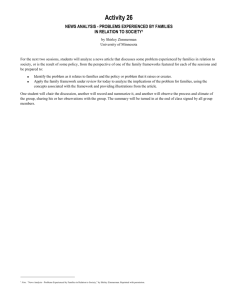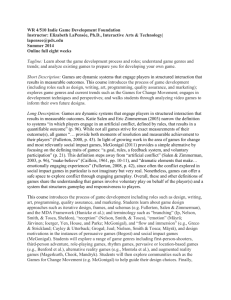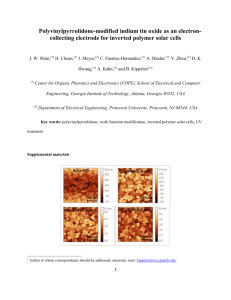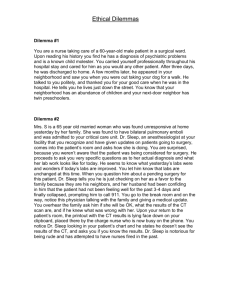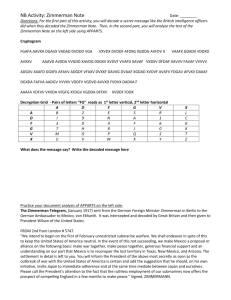Social Uses of Mobile Phones
advertisement
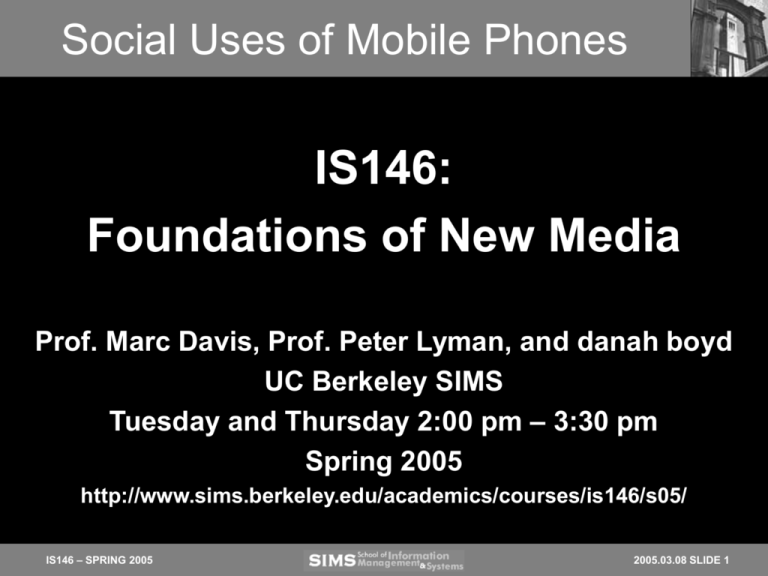
Social Uses of Mobile Phones IS146: Foundations of New Media Prof. Marc Davis, Prof. Peter Lyman, and danah boyd UC Berkeley SIMS Tuesday and Thursday 2:00 pm – 3:30 pm Spring 2005 http://www.sims.berkeley.edu/academics/courses/is146/s05/ IS146 – SPRING 2005 2005.03.08 SLIDE 1 Lecture Overview • Review of Last Time – Information Theory – The Telephone from Bell to Cellphones • Today – Social Uses of Mobile Phones • Preview of Next Time – Reading Visual Representations I IS146 – SPRING 2005 2005.03.08 SLIDE 2 Lecture Overview • Review of Last Time – Information Theory – The Telephone from Bell to Cellphones • Today – Social Uses of Mobile Phones • Preview of Next Time – Midterm Study Guide – Reading Visual Representations I IS146 – SPRING 2005 2005.03.08 SLIDE 3 Information Theory • Claude Shannon in the 1940’s studying signal communication • Ways to measure information – Communication • Producing the same message at its destination as that seen at its source – Problem • A “noisy channel” can distort the message • Semantic aspects are irrelevant Noise Message Source Transmitter Receiver Destination Channel IS146 – SPRING 2005 2005.03.08 SLIDE 4 Human Communication Theory? Noise Message Source Transmitter Receiver Destination Channel IS146 – SPRING 2005 2005.03.08 SLIDE 5 Daniel Delmore on Salen & Zimmerman • Weaver says that, "information is a measure of one's freedom of choice when one selects a message.” ... What are some examples of games that test the information theory and the description listed above? IS146 – SPRING 2005 2005.03.08 SLIDE 6 Daniel Delmore on Salen & Zimmerman • Noise increases the uncertainty of the signal, and therefore the amount of information it contains. Is this concept of noise a good thing when it comes to information? Specifically is this a safe or not? In what context/environment is “noise” good to exist in? IS146 – SPRING 2005 2005.03.08 SLIDE 7 Daniel Arnold on Salen & Zimmerman • Salen and Zimmerman generally define information as "a measure of how certain you can be about the nature of a signal," emphasizing that the more uncertainty, the more information. Does this definition reduce the amount of information present in society? Given this definition, would you (still) consider people to be bombarded with information overload? IS146 – SPRING 2005 2005.03.08 SLIDE 8 Daniel Arnold on Salen & Zimmerman • Assuming that information simply is based on uncertainty, would this decrease the reliability of information? How do we assign credibility if all information depends on uncertainty? IS146 – SPRING 2005 2005.03.08 SLIDE 9 Daniel Arnold on Salen & Zimmerman • According to Salen and Zimmerman, "Noise increases the amount of information and uncertainty in a message." How would noise increase the amount of information in any given message? Is not all the information of a message contained in the signal itself? How exactly, does background noise add information? IS146 – SPRING 2005 2005.03.08 SLIDE 10 Daniel Arnold on Salen & Zimmerman • Given the separation of meaning and information, can meaning be labeled information when it contains some ambiguity? For instance, when a word can be defined in several different ways. IS146 – SPRING 2005 2005.03.08 SLIDE 11 Lecture Overview • Review of Last Time – Information Theory – The Telephone from Bell to Cellphones • Today – Social Uses of Mobile Phones • Preview of Next Time – Midterm Study Guide – Reading Visual Representations I IS146 – SPRING 2005 2005.03.08 SLIDE 12 Mizuko (Mimi) Ito • Annenberg Center for Communication (University of Southern California) • Stanford: PhD in anthropology; PhD in education • Believes in youth empowerment, youthcentered ethnography • Studies mobile phone culture and media mixing IS146 – SPRING 2005 2005.03.08 SLIDE 13 Keitai Culture in Japan • SMS (texting) vs. keitai internet email – Different technological protocols • Economics and social practice in Japan – Myths: cheaper, easier – Carriers – ¥7,521 ($72) - average student bill/month • Why does texting work there and not here? IS146 – SPRING 2005 2005.03.08 SLIDE 14 Slides from Mimi Ito • Slides from Mimi Ito shown in lecture not posted • For a related web-accessible talk from Mimi Ito see: – Ito.ppt Title: Understanding the Mobile User: The Case of Japan Author: Mimi Ito research associate, USC Annenberg Center for Communication; Mellon Teaching Fellow, USC department of Anthropology IS146 – SPRING 2005 2005.03.08 SLIDE 15 Diary Study • What is a diary study? – Record every interaction with the mobile – Indicate meta commentary – Complements data record • When are diary studies useful? – Interactions over extended periods of time – Want to know what people are thinking during interaction before they forget IS146 – SPRING 2005 2005.03.08 SLIDE 16 Cheskin Research: Who • We are 23 musicians, 4 self-professed tech geeks, 8 public performers, 2 scuba divers, 1 competitive water skier, 3 sailors, 2 futurists, 13 non-profit volunteers, 7 lefties, 2 aspiring novelists, 1 surfer, 4 fine artists, 1 pilot, 6 nature lovers, and 1 Taiko drummer. • We come from more than 20 different countries and cultures. We speak English, Spanish, Portuguese, Mandarin, Cantonese, Vietnamese, Japanese, Tagalog and a few others. • We also have professional design principles. We have academic credentials in psychology, sociology, anthropology, design, e-business, media, branding, identity, communications, advertising, product development and packaging. We have long experience in many markets. And we find that all of the above feeds all of the above. IS146 – SPRING 2005 2005.03.08 SLIDE 17 Cheskin Research: Design Principles • Understand what others don't. – • Be a powerful presence. – • Discover the thing that makes you unique, and use it to differentiate yourself. Express it in everything you do and mind the details. Go beyond the norm by finding creative ways to add value to every brand experience. Make change. – • Listen. Observe. Pay attention to the needs and aspirations of others, and strive to fulfill them -- but only promise what you know you can deliver. Make compassion and responsiveness your hidden agenda. Distinguish yourself. – • Know who you are, what you stand for, and what makes you different. Create a distinct position through your products and practices, and use design to tell the world. In all your actions, be authentic -- use your own voice, your own words, and your own style. Be relevant. – • Observe the world. Be rigorous as you face the facts. Look past conventional wisdom, question everything, and keep on diving until you find a unique perspective. Catalyze your community with positive action. Be passionate in your beliefs, prescient in your observations, and proactive in your behavior. Stick your neck out, and make a real difference. Evolve or die. – Size, age, and wealth are no defense against change and no excuse for complacency. Stay alert, stay flexible, stay current, and embrace change. IS146 – SPRING 2005 2005.03.08 SLIDE 18 Cheskin Research: Methods and Goals • Methods – Quantitative primary research with teens, age 13-18, and young adults, age 19-24 – Interviews with industry experts – Secondary research • Motivations for wireless study – Youth influence larger consumer trends – Figure out new wireless product and service offerings • Goals – Understand the phenomena being observed – Advise customers about what actions to take based on that understanding – Sell these services and the value of their approach IS146 – SPRING 2005 2005.03.08 SLIDE 19 Cheskin Research: The Wireless Future 1. Social connectivity and entertainment will be the primary defining characteristics of wireless devices in the youth market, and likely the consumer market at large 2. Young people will build relationships via wireless devices 3. Multitasking capabilities will flourish within the youth market 4. Personal security and convenience will continue to be motivating factors for first time mobile phone consumers IS146 – SPRING 2005 2005.03.08 SLIDE 20 Cheskin Research: The Wireless Future 5. Personalization of design, function, and interface will be a common expectation 6. Wireless entertainment and information applications will become favored "gapfillers" 7. Strategic convergence will define the most successful wireless devices 8. Entertainment will drive the development of wireless cross-platform content IS146 – SPRING 2005 2005.03.08 SLIDE 21 Ito and Cheskin on Mobile Youth • How do their methods, motivations, and goals compare? • How do their findings compare? • What factors affect the similarities and differences? IS146 – SPRING 2005 2005.03.08 SLIDE 22 Nick Reid on Ito and Okabe • How do “social spaces” intersect? What I mean is, if there is a situation where a group of people are together, and through telepresence, how does this outside party enter into a group? How is their presence felt by people who are there or are not there, would it really seem like the person is in the next room? IS146 – SPRING 2005 2005.03.08 SLIDE 23 Nick Reid on Ito and Okabe • A question that would be fun to discuss is what counts as “contact”? Is contact a hug or is contact a SMS? Does a communication not being “physical” demean the communication? “When a situation is predictable there is no information present.” Another question would be, does contact actually have to transmit information? IS146 – SPRING 2005 2005.03.08 SLIDE 24 Steven Lybeck on Ito and Okabe • Ito and Okabe show that new technologies are spawning the creation of virtual social spaces that are quite analogous to physical ones. Could these virtual spaces supersede or even replace interaction in physical spaces? Why or why not? IS146 – SPRING 2005 2005.03.08 SLIDE 25 Steven Lybeck on Ito and Okabe • Are there any examples of virtual spaces constructed without the use of new media technologies? IS146 – SPRING 2005 2005.03.08 SLIDE 26 Lecture Overview • Review of Last Time – Information Theory – The Telephone from Bell to Cellphones • Today – Social Uses of Mobile Phones • Preview of Next Time – Midterm Study Guide – Reading Visual Representations I IS146 – SPRING 2005 2005.03.08 SLIDE 27 Midterm Study Guide • Midterm structure – Short answer questions – Ethnographic analysis question – LOGO programming analysis question • Studying tips – Use midterm study guide – Study in groups – Be prepared to answer all questions on your own IS146 – SPRING 2005 2005.03.08 SLIDE 28 Readings for Next Time • Gunther R. Kress and Theo van Leeuwen. Reading Images: The Grammar of Visual Design, London: Routledge, 1995, p. 1-42. – Discussion Questions • Onesta Francis • Natalie Torin IS146 – SPRING 2005 2005.03.08 SLIDE 29

